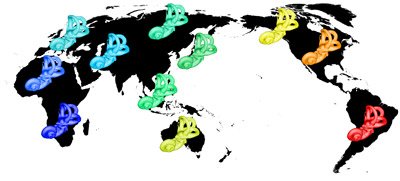Using AI to control energy for indoor agriculture
30 September 2024
Published online 5 April 2018
High-resolution imaging reveals evolutionary history hidden in our inner ear.

© PNAS
Enlarge image
Genetic analyses offer compelling evidence that humans dispersed from Africa, and the genetic distance between populations correlates well with their geographic separation. However, genetics may not capture the entire story, and many archaeological samples don’t contain enough DNA for analysis. Researchers supplement these analyses with data about physical attributes, known as phenetic data.
Skeletal remains are a valuable source of phenetic data, but the shape of bones is also affected by factors such as lifestyle, obscuring the variation necessary for demographic analysis. Christoph Zollikofer, of the University of Zurich, suspected that the cavity system of the inner ear, known as the bony labyrinth, might be ideal for these demographic analyses, since it is fully developed at birth and well preserved in archaeological samples.
An international collaboration led by Zollikofer used high-resolution computed tomography to study 221 inner ear cavities collected from 22 populations around the globe and spanning the past 6,000 years.
Their analysis revealed a geographic structure, with differences in shape of the bony cavity correlating with the dispersal distance from Africa. The team also found a correlation between the morphology of the bony labyrinth and genetic dispersal estimates.
“Combining genetic with phenetic data is the gold standard of evolutionary biology. Only when we understand how genes are translated into morphological features can we understand the evolutionary significance of the genes,” says Marcia Ponce de León, the lead author of the study.
The study was praised by Katerina Harvati, an anthropologist at the University of Tübingen, who wasn’t involved in the research. “Of course, getting ancient DNA is not possible for all archaeological and fossil specimens, so it is important to understand the phylogenetic significance of phenotypic features like this.”
According to the Harvati, these analyses show that the morphology of the inner ear cavity is a valuable source of information about ancient populations. “Our bony labyrinths are like historical archives of our roots in space and time,” she adds.
The team recommends that future studies capture high-resolution morphological data from skeletal samples before using destructive techniques, such as genetic sampling, to extract organic material.
“We hope that our study acts as a wake-up call to document labyrinth morphology before ancient DNA extraction” says Zollikofer, stressing that “genetic, phenotypic, geographical, and temporal data are required together to understand the evolutionary and dispersal history of humans.”
doi:10.1038/nmiddleeast.2018.42
Stay connected: